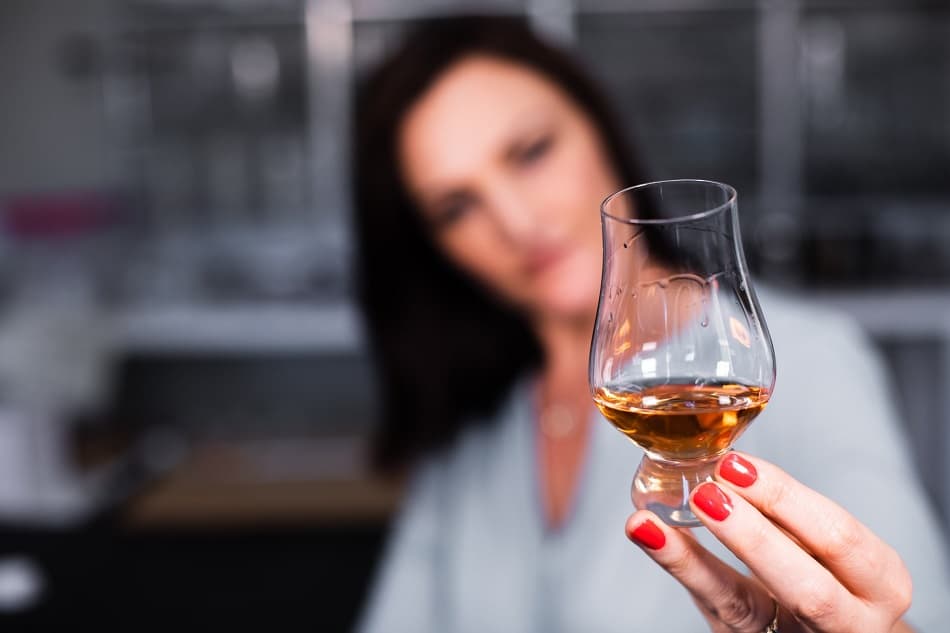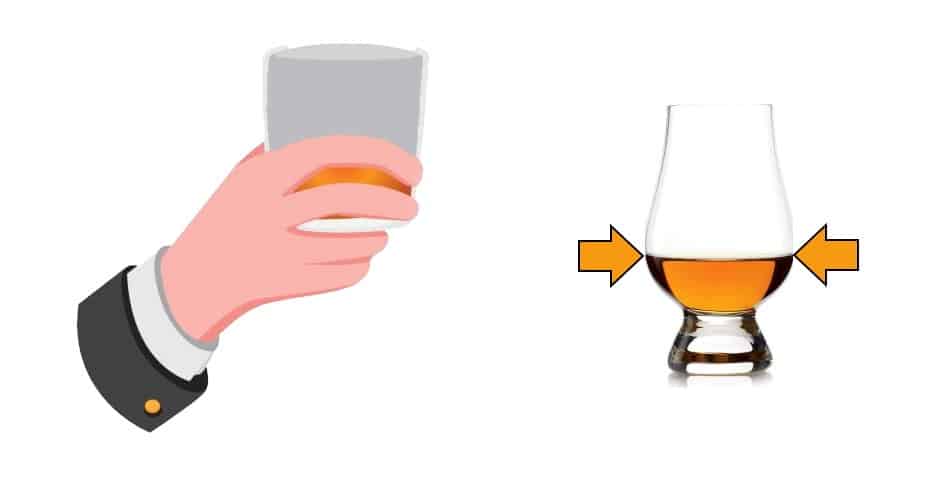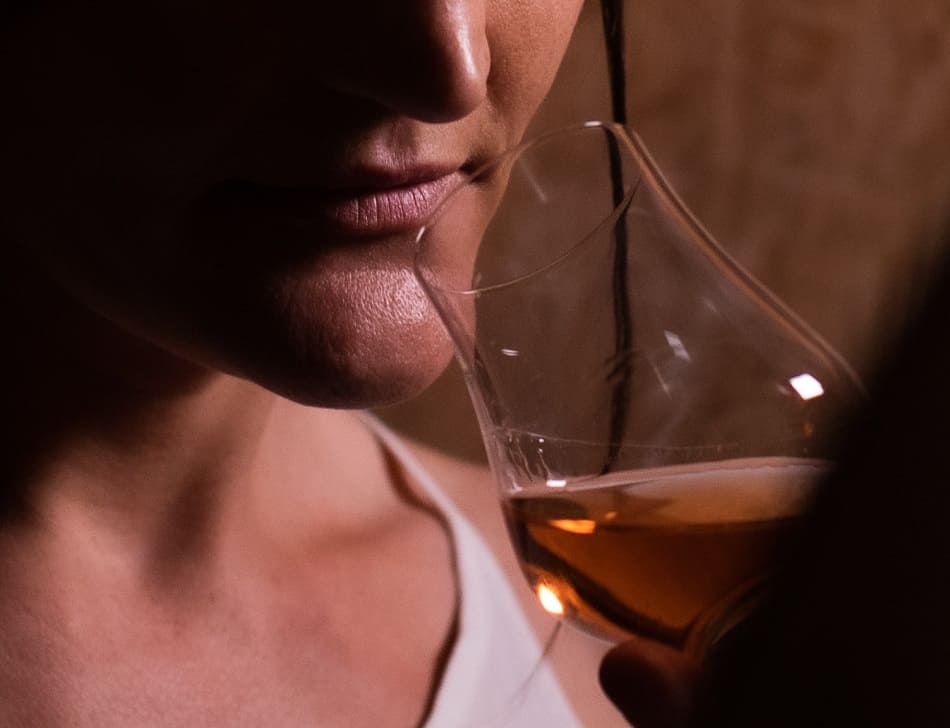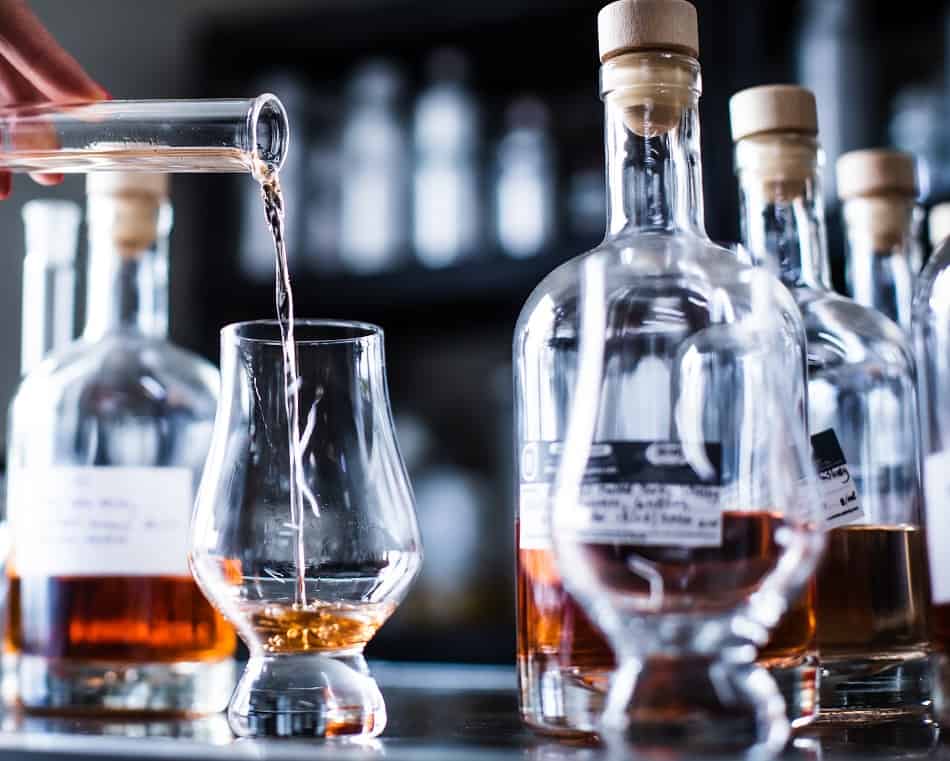I like drinking whiskey neat because that way I’m able to taste all its flavors, but since there’s more to it than sipping and swallowing, it took me some time to learn how to do it properly. It’s not difficult at all, but there are lots of different things you need to know. Here’s my detailed, step by step guide showing you exactly how to drink whiskey neat.

1. Get Hold of a Nosing Glass
A nosing glass is essential to drinking whiskey neat because without one you won’t be able to taste all the flavors of your whiskey.
This is because whiskey has a lot of alcohol (between 40%ABV and 68%ABV) which keeps some of the whiskey’s flavors closed up and dominates those that aren’t making it difficult to smell or taste them.
It’s also because flavor is smell as well as taste, so you’re going to need to pick up all the whiskey’s aromas if you want to taste all its flavors.
Nosing glasses are specifically designed to deal with these two things. They reduce the impact of the alcohol and ensure you’re able to detect all the aromas of your whiskey.
They do this via their shape – wide bowl and long narrow neck. The wide bowl allows air to get to the whiskey so it can breathe. Some of the alcohol will then evaporate making it less dominant, and the whiskey will open up releasing more of its flavors.
The long narrow neck is a place for the whiskey’s aromas to accumulate, ensuring you don’t lose them to dissipation.
On the other hand, if you use a shot glass to drink whiskey neat where there’s no room for air to get to the whiskey and nowhere for the whiskey’s aromas to accumulate, you’d smell the fumes of the alcohol which won’t have evaporated, but not the aromas of the whiskey which will have dissipated. You won’t be able to taste the flavors of the whiskey, but you will feel the burn of the alcohol.
One of the most popular whiskey glasses is the Glencairn Whisky Glass which you can find on Amazon here .
.
Tip: Hold your glass by the stem not the bowl so your hands don’t warm the whiskey, and so that they and their smells (even pleasant ones) are kept away from your nose.
2. Pour 2 fl oz of Whiskey and Let It Sit
When you drink whiskey neat the point is not to get drunk (for which a 1 or 1.5 fl oz shot would be enough) but to have a substantial drink whose flavors you can explore over four or five sips. That’s why a normal amount to pour when drinking whiskey neat is 2 fl oz.
Don’t worry if you don’t have a jigger or another tool for measuring out the whiskey precisely, you can always use the two fingers rule which just means pouring until you reach the width of two fingers held against the glass (the width of one finger against a regular sized glass is about 1 fl oz), or the other rough guide which is to pour to the level of the glass where its diameter is widest.

Once poured you should let your glass of whiskey sit untouched for a few minutes. This gives the air, which since you’re using a nosing glass can get to the whiskey, time to cause some of the alcohol to evaporate and let more of the whiskey’s flavors open up.
Some claim that whiskey should be left sitting one minute for every year of its age, but you can’t go wrong if you wait a little longer. You probably won’t want to wait too long but on the other hand, a glass of whiskey that’s been left to sit for a couple of hours will probably have much more intense aromas and flavors than one left to sit for only a few minutes.
Tip: Swirling your whiskey lets even more air get to it.
3. Smell the Whiskey to Detect Its Aromas
Now that the impact of the alcohol has been reduced and the whiskey’s flavors have opened up, it’s time to smell your whiskey.
Put your nose into the glass and breathe in deeply but gently. Your olfactory system is delicate so don’t breathe in over aggressively as you might get singed by the alcohol. Don’t hold the glass to your nose or near your nose, get your nose right inside the glass.
Open your mouth slightly as you inhale to let the alcohol fumes escape and the whiskey aromas circulate round so you can better detect them. You’ll probably get an overpowering sense of alcohol the first time, but as your nose gradually acclimatizes to it, each smell will pick up more and more of your whiskey’s aromas. Take your nose out of the glass between each sniff.
Sniff using one nostril and then the other. Generally, one nostril is responsible for 80% of an inhalation while the other is obstructed, so each nostril will perceive the aromas differently. You won’t know which one is which because it alternates every two to three hours.
Vary your rate of inhalation because some aromas are easier to detect when the flow of air is quick while others are easier to detect when the flow of air is slower.
Examine every part of the glass because different aromas concentrate at different points. At the bottom you’ll find the heavier compounds with earthy, smoky, woody, aromas, higher up will be the spicy, malty, winey aromas and towards the rim are the lighter fruity and floral aromas.

Tip: If you’re finding it difficult to think of good words to describe what you’re smelling, you can use a whiskey aroma wheel . These are visual representations of words commonly used to describe aromas, grouped together in families with aromatic similarities.
. These are visual representations of words commonly used to describe aromas, grouped together in families with aromatic similarities.
They can be helpful as you’ll get a better idea of the type of words that describe aromas, and you’ll also have a list of them you can use instantly. Be careful not to rely too heavily on them as they’re not the sum total of all descriptors and you don’t want to confine yourself based on their limitations.
Tip: Don’t worry if your descriptions of the aromas are different to those of other people. The perception of smell is a personal thing so what smells like one thing to one person may smell like something else to another. It’s also because smells are linked to memories, so depending on your psyche, personal descriptors may be quite unusual.
Tip: Take your time. This could take you a minute or two.
4. Sip and Chew the Whiskey to Taste Its Flavors
When you’ve finished nosing your whiskey (yep nosing is just a fancy way of saying smelling. Congratulations on becoming posh) you’re ready to taste it.
First, drink a small sip without necessarily tasting it. I know that seems counter intuitive, but the point here is to get your mouth acclimatized to the alcohol. (You did a similar thing with your nose). The first sip (like the first smell) will probably taste overwhelmingly of alcohol but with the second you’ll start to taste some of the whiskey’s flavors.
Take the second sip but this time don’t swallow it yet. You need to chew your drink. This means, holding it in your mouth and swirling it around, making sure it spreads throughout your mouth and covers all the surfaces of your tongue – the middle, the sides, the tip and the back – because different parts of your tongue respond to different flavors.
Now you’re going to try and assess your whiskey. Ask yourself the following questions:
- What does the whiskey feel like in your mouth (called the mouthfeel)? Is it thin, medium or thick? Is the texture soft, oily, creamy or silky?
- Is the whiskey soft and smooth or harsh and burning?
- What flavors can you detect?
- Are the flavors sweet, spicy, fruity or smoky?
- Are there a lot of flavors or are there only a few?
- Are the flavors rich, bold and intense or are they mild and light
- Can you detect all the flavors immediately or do some only appear midpalate as the taste unfolds in your mouth?
- Are the flavors well integrated and balanced or do some dominate?
Again, if you’re finding it difficult to think of good words to describe what you’re tasting, you can use an aroma wheel.
Yes, it’s a lot to think about in such a short period of time but with practice it’ll become second nature.
And swallow.
Take a deep breath and exhale through your nose so that the aromatic molecules in your mouth go to the back of your throat and rise up into your sinuses.
Don’t take another sip yet.
Wait a moment so that the taste can come back up. This is called the finish. It can be short, medium or long, with some or all of the flavors you already tasted and sometimes even new ones. It will change as the flavors fade in your mouth.
Now you can take another sip.
Tip: Take your time here too. Another minute or two to chew the whiskey and taste its flavors and another minute to explore the finish. It’s not unusual to spend 20 – 30 minutes drinking a glass of good quality whiskey.
Tip: If you find the strong taste of something you ate or drank earlier is preventing you tasting the flavors of your whiskey, try cleansing your palate by eating water crackers, white bread, tortilla chips, fruit or vegetables. If that doesn’t work, you’ll have to wait until the strong taste disappears.
Tip: If you’re finding things difficult, it could be that you and / or your palate are fatigued, making you less sensitive to the whiskey’s flavors, and less able to concentrate on detecting them. The best time to drink whiskey neat is when you and your palate are alert.
5. Add a Few Drops of Water between Sips

Although technically speaking neat, when applied to alcoholic drinks, means, ‘… a single, unmixed liquor served without being chilled and without any water, ice, or other mixer …’ many people add water when drinking their whiskey neat.
They do this as another way to reduce the impact of the alcohol and get the whiskey’s flavors to open up. The use of a nosing glass does this by getting some of the alcohol to evaporate but adding water does this by diluting your whiskey.
Now this doesn’t mean you should just add lots of water to your whiskey because of course, you can dilute it too much and ruin its flavor entirely. Instead, start by adding a few drops of water, taste your whiskey to see its effect and add more if you think it necessary later.
There’s no prescribed amount of water to add because it will be different for every person and every whiskey. To get the most flavors from drinking whiskey neat you’re going to need to experiment to discover the amount of water to add that will make a given whiskey taste best for you.
Tip: Be careful as to the type of water you add to whiskey. If it tastes bad, so will your whiskey. Use neutral, slightly cool water so it won’t affect your whiskey’s flavors. If your tap water has a distinctive taste, you should filter it or use bottled water.
6. Keep Drinking and Exploring Whiskey(s)
Learning how to drink whiskey neat can take time. You may not pick up very much on your first few attempts, but like anything else it becomes easier with practice. Fortunately, practice in this case means drinking whiskey, so even if it takes years to become fully expert, the level of skill you reach after even a short amount of time, makes the journey delicious pretty much from the start.
Here are some things you can do to improve your smelling and tasting abilities:
- Try different types and styles of whiskey.
- Try two or more whiskeys side by side. Comparing things is always easier.
- Try to be as specific as you can about what you’re smelling or tasting.
- Take notes. That way you can build a picture of the aromas and flavors you like.
- Drink whiskey with other people. They may pick up on something you haven’t.
- Taste foods and drink with specific aromas and flavors to learn what they smell and taste like.
- Practice your nosing and tasting abilities on other foods and drink where the aromas and flavors are easier to detect.
Good luck!

